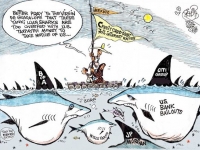Mexico's Other Crisis: Foreign Banks

In the early 1990s, U.S. tycoon Ross Perot criticized the proposed North American Free Trade Agreement (NAFTA) for threatening to suck U.S. jobs south. In the 15 years since the trilateral agreement, another giant sucking sound is coming - but from the flow of pesos across the Rio Grande and over the Atlantic into the coffers of foreign banks that are charging millions of Mexicans usurious rates that can top 100 percent.
Jorge Sanchez is feeling the effects. A modestly paid government employee in his 40s, Sanchez fell into the plastic trap. Trying to close the gap between a stagnating salary and a desire for a higher standard of living, he took out a bank-issued credit card. Soon he had a half-dozen of them in his billfold. Even before the peso went into free-fall last autumn and a wave of lay-offs added economic stress, more than 10 percent of Mexico's 50 million consumer credit accounts - issued by banks, cell phone companies and department stores - were delinquent, according to a spokesman for Mexico's Credit Bureau.
Panic over Influenza A(H1N1), or swine flu, will further impact ordinary Mexicans as dollars from tourism and other income sources dry up.
"A moment came when my entire paycheck went to pay off credit cards," recalls Sanchez. "There was hardly anything left over to eat with or for the house, which has a mortgage." Sanchez took out a $5,000 loan from a private savings and loans fund. As interest and fees accumulated, his nearly $1,000 credit card debt with Citigroup-group owned Banamex bank doubled and was turned over to bill collectors. Sanchez says he faced two separate groups of attorneys with "very aggressive" attitudes and no willingness to negotiate.
Up against the wall, the Aguascalientes resident filed a complaint with the federal government's National Commission for the Protection and Defense of Financial Services Users (Condusef), an agency that works out agreements between credit card debtors and lending institutions. Sanchez's Banamex problem was resolved, but what really saved him was a lump-sum payment owed to him and other workers by the federal government. Without the extra money, Sanchez muses, his future could be bleak.
"I don't want to even think about it," he adds. "It surely would've been hell."
Sanchez is a survivor of the Mexican debt trap. Many others are not so lucky. According to the latest press reports, more than 5.1 million credit card accounts in Mexico are now considered bad. Esteban Sotelo, regional director for Condusef in the southern state of Guerrero, says bad credit card debt in Mexico has reached "unprecedented levels."
Javier Taja, president of the Guerrero state branch of the El Barzon organization, a national debtors' advocacy group, estimates that of 200,000 credit card holders in Acapulco alone, some 85,000 people are in arrears. Taja says he knows people who earn less than $800 a month but have credit card balances exceeding $23,000.
"Many young people are landing in the Credit Bureau, and this will cause an economic contraction later on because we aren't going to have consumers," Taja says. "All we're going to have is people in the Credit Bureau."
Sotelo blames the crisis on free-wheeling lending practices by banks as well as consumers' poor personal finance management skills. Last year, Sotelo's Acapulco office handled 7,025 cases of people seeking to resolve a problem with financial institutions, mostly having to do with credit cards. The case load was nearly a 30 percent increase over the previous year.
"People don't know how to use credit," Sotelo insists. "The problem is that people aren't paying because they have more than one card."
It used to be very difficult to obtain a credit card in Mexico. Then, like street hustlers hawking passes to strip shows, young "promoters" working for the banks appeared on the streets virtually handing out credit cards. From 2001 to 2008, the number of credit cards circulating in Mexico soared from 6.1 million to 26.1 million, according to Condusef. Maintaining offices in Los Angeles and New York, Banamex USA even offered a cross-border credit card program aimed at clients with friends or relatives in Mexico.
(In 2008, Banamex inaugurated a branch in Calexico, California.)
Eligible income levels were dropped to unheard of lows of about $300 monthly, only slightly above official definitions of "poverty wages," and certainly not enough to establish any stability or cushion.
An emblematic story involved a four-year-old girl, Daniela Elizondo, whose father was stunned to learn by mail that his daughter had been approved for a list of "select" credit card clients.
For banks (and government), the Mexican credit card business is highly profitable. In the United States, complaints soared when credit card interest rates reached the 20-35 percent range, but in Mexico, the Total Annual Cost (CAT) for bank-issued cards rose from 37-103 percent in early 2008 and to 47-113 percent by January 2009, according to Sotelo.
The CAT includes interest rates, assorted fees and the national value-added tax. A Condusef study found that a cardholder who began with a $1,000 debt and made only minimum payments would wind up forking over $7,500 in a 15-year period.
The banking industry disputes Condusef's definition of the CAT, preferring to define it based on the interest rate alone. In a presentation at the annual banking convention in Acapulco in March 2009, Mexican Bank Association (ABM) President Enrique Castillo maintained that commissions charged by his members were internationally competitive. "We aren't the cheapest, we aren't the most expensive," Castillo said.
While most Mexicans have scrambled to get by in recent years, the banks have enjoyed a golden era. In good years annual profits hover around 12 to 14 percent, according to the ABM's own numbers. Even in gloomy 2008, Mexico's banks raked in about $5 billion in earnings, according to the National Banking and Securities Commission (CNBV). Sometimes called "the crown jewel" of Citigroup, Banamex alone earned nearly $1 billion in profits, a figure down $500 million from the previous year.
Exporting Profits
To call banks in Mexico "Mexican" is almost a misnomer. Analysts estimate foreign capital controlled 80 to 90 percent of the assets of the 43 banks registered by the CNBV at the end of 2008. The largest banks are the U.S.-owned Banamex, the Canadian-run Scotia Bank, the United Kingdom's HSBC, and Spanish-owned Bancomer (BBVA) and Santander. Bank of America, Prudential, Wal-Mart and J.P. Morgan, among others, have also entered the Mexican financial services market.
The profits from Mexico's credit card bubble have been flowing north to U.S. financial giants and across the Atlantic to Europe's money centers.
| Banks Across Borders Bank of America, Banamex, Citigroup, HSBC, BBVA, ING and Santander teamed up late last year to engineer a $2.38 billion buy-out of the U.S. operations of Canada-based George Weston Limited by Bimbo, the giant bread, snacks and other foods company founded by conservative Mexican businessman Lorenzo Servitije. The purchase greatly helped Bimbo consolidate its position as one of the leading baking and food companies in the world. Recipients of U.S. government bailout money, Citigroup and Bank of America, greased the wheels of the deal after they announced lay-offs of tens of thousands of workers in the United States. In Mexico, foreign bank bailouts have had their own repercussions. Under Mexican law, foreign governments are not permitted to own banking assets in Mexico. When the U.S. government acquired a 36 percent ownership stake in Citigroup, Banamex's parent company, Mexican opposition politicians said Banamex was now operating in defiance of the law. Calderon administration officials issued contradictory responses, first insisting that international free trade agreements signed by Mexico rendered the ownership law obsolete. Treasury Secretary Agustin Carstens later said Banamex had three years to shed itself of foreign government involvement. "Can you all explain to me?" wrote a reader of the daily La Jornada website. "In what law or part of the Constitution can you violate a law for three days, three months or three years, without punishment?" Besides Banamex, several other banks in Mexico are in the same legal quandary, including the Dutch ING bank and the Royal Bank of Scotland, both of which have been propped up by their respective governments. The foreign government ownership controversy could wind up in Mexico's Supreme Court. By virtue of its new ownership interest in Citigroup, the Obama administration has, for all intents and purposes, put its stamp of approval on the corporation's Mexican business practices, including the extremely high interest rates charged to credit card holders. Calls to the U.S. Treasury Department for comment were not returned. Based in the northern industrial city of Monterrey, Banorte is the sole remaining big Mexican-owned bank. Its principal stockholder is Roberto "Tortilla King" Gonzalez Barrera, who also leads Grupo Maseca, the giant corn flour milling and tortilla-making business that dominates the market in North America, Central America, and beyond. Maseca's rival in the staple tortilla market is none other than Bimbo. In the past, Gonzalez has been associated with the family of ex-president Carlos Salinas de Gortari. Nowadays, Gonzalez and Banorte have their sights set on U.S. expansion. The Mexican bank recently completed a take-over of the Texas-based Inter National Bank, a lending institution that offers mortgages to U.S. and Canadian citizens for vacation properties in Mexico. |
Besides the high interest rates charged for credit cards and other loans, other factors help explain the profitability of Mexican banks. Government and academic studies recently cited in the Mexican media found that more than half of all bank employees were actually outsourced workers.
In addition to not having to negotiate with pesky unions, banks could avoid paying standard benefits as well as profit-sharing payments and end-of-the-year bonuses stipulated by Mexican law.
Especially in the last ten years, banks have taken their cut of the large sums of money sent home by Mexicans working in the United States.
Then there is the notorious banditry of ATM machines. This writer got a taste of the scam in Mexico City last year when he attempted to withdraw about $120 from an ATM but was flashed a message that cash was temporarily unavailable.
Nonetheless, a $120 debit appeared on a subsequent Visa statement. Despite protests, Visa stood behind the "debt."
During the last trimester of 2008, when the world was in the throes of an economic meltdown, Visa's profits registered a 35 percent increase.
Public anger over the high cost of banking is simmering on the streets and boiling over in cyberspace, with some writers even urging a credit card payment boycott. In 2009, teachers, supporters of former presidential candidate Andres Manuel Lopez Obrador, and others have organized demonstrations in different cities against foreign-owned banks.
Some banks have responded with a public relations offensive. A recent full-page newspaper ad taken out by Banamex claimed that during recent years the bank has reinvested all its profits in Mexico.
"We have invested $30 billion in Mexico," read the ad, "More than any other bank or business." Banamex has not yet responded to a written request for information or comment.
To calm the public anger, Condusef recently worked out an agreement with the ABM for its members to begin negotiating with credit card debtors to reduce payments. For its part, Bancomer now offers to periodically reduce interest rates for its clients who pay credit card bills on time.
In April, the Mexican Senate passed legislation to give the national Bank of Mexico power to regulate interest rates, outlaw some commissions, publicize interest rates of banks for consumer credit comparison purposes, and levy light fines on lawbreakers. The measure, however, fell far short of consumers' demands to limit interest rates.
"I would like to see lower interest rates, but I don't recommend measures like capping interest rates on credit cards," Condusef President Luis Pazos said in a statement, "since this would remove from the bank credit card market people with modest incomes, and could force them to seek credit at higher interest rates in the informal market, like what happened in Colombia and Chile."
Pazos' arguments find echo north of the border, where a U.S. effort to cap credit card interest rates at 15 percent was defeated in April. A measure sponsored by Senator Bernie Sanders (I-VT) was voted down 66-32 in the Democrat-dominated Senate. Similar to the Mexican approach, President Barack Obama supports a new law that would require better disclosure of credit card terms by banks, prohibit double-cycle billing, make it illegal to grant credit cards to minors, and stress greater enforcement of existing laws. Legislation akin to the president's preferences overwhelmingly passed the U.S. House late last month and is now set for a battle in the Senate.
In Mexico and the United States, the prevailing political forces have carefully avoided direct action to curb the banking industry's high interest rates, which, in the past, would have been widely considered usurious.
And Then the Flu Hit
In response to criticism that bad credit card accounts and other bad debts will precipitate a new financial crisis in Mexico, the banks and their government allies were not publicly worried in the days before the H1N1 (swine) flu epidemic hit. New lines of credit available from the International Monetary Fund and the U.S. Federal Reserve totaling $77 billion shored up Mexico's potential foreign reserves to more than $150 billion this month, permitting the Calderon administration to announce it will support new economic investments. Oddly enough, the possible infusion of cash - which could prop up the shaky peso and serve as an emergency, hog-sized piggy bank for the financial institutions - was announced on April Fool's Day in the United States.
Almost as a sweetener, the Calderon administration plans to subsidize some lagging credit card debts. Unveiling a new program for federal workers enrolled in the National Social Security Institute (ISSSTE), the government declared it will lend cash-needy workers up to $3,000 at an annual "low" interest rate of 14 percent to help pay off credit card debts. The program will help the banks cleanse their books, but keep credit card holders in debt.
The million-dollar question now, of course, is how much damage a virtual economic shutdown will do to an already stressed economy. Closely connected is the issue of whether the flu epidemic will cause even more credit card accounts to default. Mexican Senate President Gustavo Madero has publicly called on banks to modify payment due dates for debtors. The conservative politician's proposal could help out-of-work consumers in the short term, but ultimately prolong indebtedness in the long term.
At both the macro and micro-levels, a big consequence of the swine flu is likely to be an even greater pile of debt. Indeed, as the public health emergency deepened, the Inter-American Development Bank and the World Bank offered Mexico new financial assistance packages totaling nearly $300 million. And the ABM, while assuring the public it would maintain and even expand banking services, urged Mexicans to put ATM machines and credit cards to greater use as alternatives in a time of crisis.
Meanwhile, more and more Mexicans like ISSSTE member and credit card debtor Jesus Morones, another middle-aged federal worker and debtor from Aguascalientes, ask: "Who will protect the people from the banks?"
- 104 Globalization
- 124 War & Disaster Profiteering
- 188 Consumerism & Commercialism



